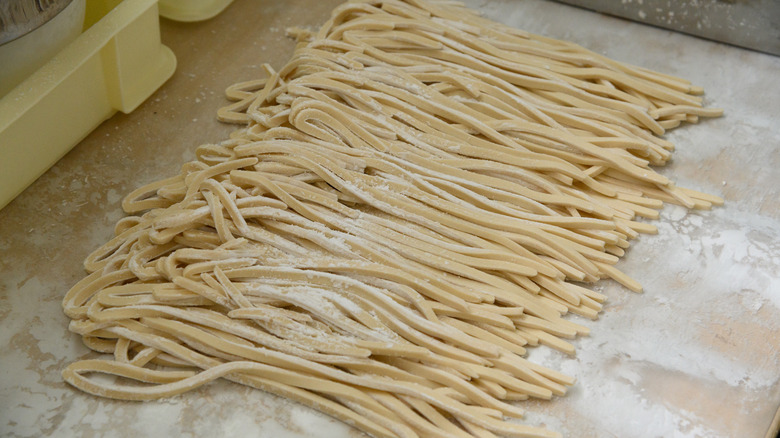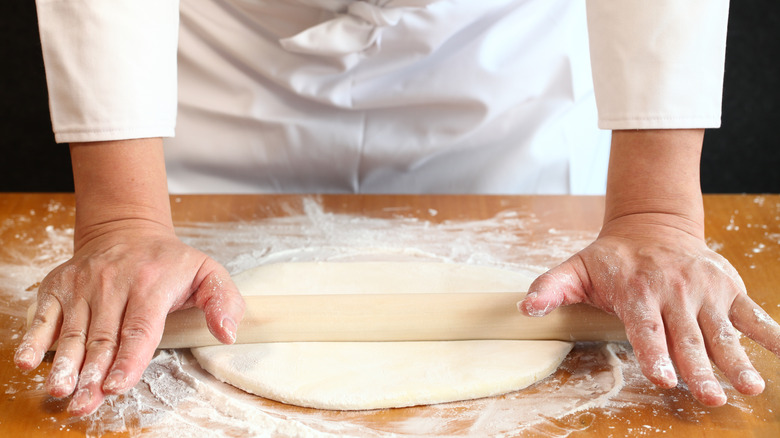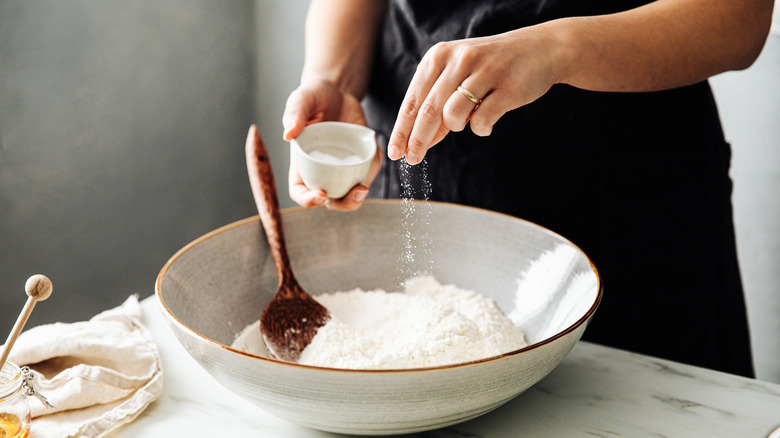The Single Ingredient That Transforms Noodle Dough From Stretchy To Snappy
In general, most noodles are made up of just flour and water. Sure, sometimes they have other ingredients — like egg or squid ink, for example — but at the base of it all is flour and water. And yet, they can take on such different characteristics. Have you ever wondered why spaghetti is so different from udon? Both are primarily made up of those same two ingredients, but their textures are worlds apart; spaghetti is toothsome but giving, while udon is bouncy and chewy. There can be differences in the type of flour used, which plays a role. But chemically, the biggest difference is the amount of salt in the dough that truly takes a noodle from stretchy to snappy.
That's because one of the primary protein molecules in wheat flour is gluten. Salt actually helps the protein in gluten form stronger bonds, creating a dough that is up to 86% stronger. Using this single ingredient in your noodles can make them tougher to stretch but more capable of doing so without breaking or deforming. Hand-pulled options like biang biang noodles are made with salt for this reason: the dough can stretch farther without tearing. This is also the same chemical reaction that makes noodles like udon so bouncy. Though, this effect is perhaps not what you want for shaping pasta noodles, however: Not only is the dough harder to roll out into thin sheets because it snaps back, it's harder to form into all the tubes, twists, ears, and bowties.
Science explains why salt makes noodles stretchier
Protein molecules of all kinds go through a process called denaturing when they're manipulated. In making food, this can happen through kneading, cooking, hydrating, or, in the case of ceviche, chemically by the way of acid. This is when the proteins unravel and link together. In the case of gluten, those link points — the bonds between the gluten protein molecules — are what develop the structure of the dough. It's what allows bread to form an airy crumb and what keeps a noodle from disintegrating in boiling water. Some flours, like hard wheat flours have a protein content as high as 12-15%. This is enough, with ample kneading, to keep the pasta together while it cooks as it will be stretchy and pliable.
All-purpose flour, on the other hand, has a lower protein content — 9-12% at the highest. To make a noodle that is really snappy, those gluten bonds need a little extra help. Adding salt to the dough will make the gluten network tighter and more compact, allowing it to bounce back and become more resistant to deformation. It's been found that salt in quantities of 1.8-2% of the weight of the flour in a bread recipe changes the way the gluten bonds together and creates a stronger web. Udon recipes often go even further to create bouncier, chewier, snappier dough both when manipulating it in your hands and when eating it with your mouth.
Creating the perfect snappy noodle
Iron Chef Masaharu Morimoto has an udon recipe in his book, "Mastering the Art of Japanese Home Cooking," that uses 500 grams of all-purpose flour and 4 teaspoons of kosher salt. Kosher salt generally weighs 5 grams per teaspoon, making Morimoto's salt a full 4% of his flour weight. Other recipes, like those from Japanese cookbook author Namiko Hirasawa Chen, use around the same amount — Chen uses 5 grams of salt and 100 grams of flour for her standard udon noodles. To make sure all of the salt incorporates well, she first dissolves it in the water to be used in the dough.
Everyone's preferences are different. Making your own noodles means you can adjust how snappy yours are by taking into account how much gluten is in the flour and how much salt is in the dough. The higher the protein content — a proxy for how glutinous your flour is — the tougher the dough will be with higher percentages of salt. By adjusting the salt measurements, you can make your noodles more or less bouncy. More salt will make a snappier noodle, but dough that is harder to work with; on the contrary, less salt will create an easier, more stretchable dough, but a less chewy noodle.
The more salt there is, the harder it will be to knead, essential to creating the perfect chewiness in the noodles. But, you can always put your whole body to work — wrap the dough in plastic and just step on your udon to achieve the desired results.


